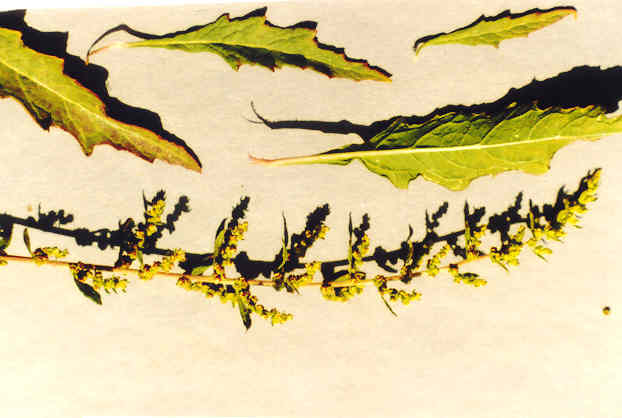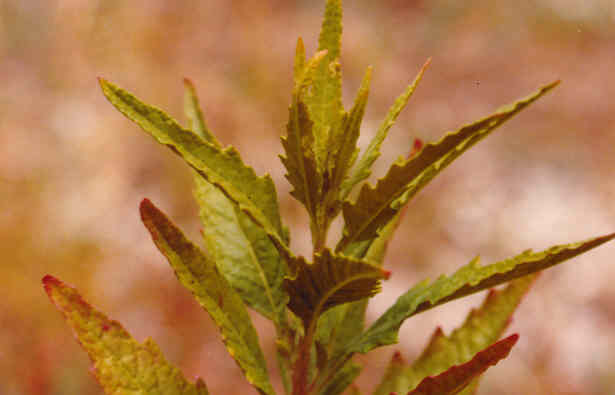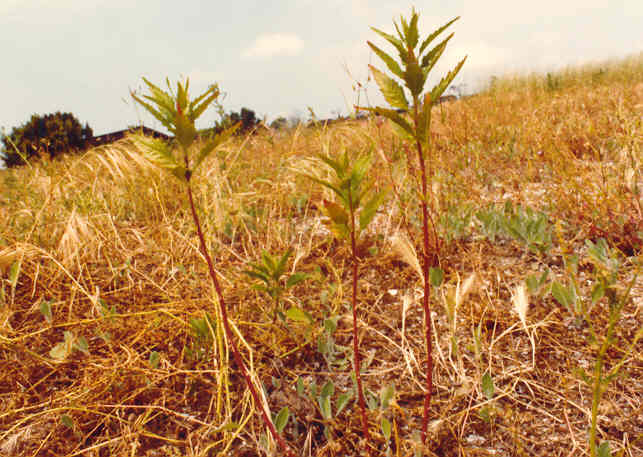
Chenopodium ambrosioides L.
Chenopodiaceae (Goosefoot Family)
Tropical America
Mexican-Tea
Epazote
 |
Chenopodium ambrosioides L.Chenopodiaceae (Goosefoot Family)Tropical America
Mexican-TeaEpazote
|
July Photo
Plant Characteristics:
Annual or perennial, erect or ascending, coarse, strong-scented, the
stems 4-10 dm. long, simple or branched, smoothish; lvs. short-petioled, oblong
or lanceolate, subentire to repand-toothed, 2-10 cm. long, gradually reduced
upward; infl. a slender pyramidal panicle of densely-fld. spikes, elongate,
leafy or intermixed with lvs.; calyx ca. 1 mm. long, gland-dotted, enclosing the
fr.; pericarp very thin, deciduous,
gland-dotted; seed horizontal or vertical, ca. 0.7 mm. broad.
Habitat:
Weed in waste, especially damp places, particularly in s. Calif., but
widespread on Pacific Coast and to New England.
June-Oct.
Name:
Chenopodium is from two
Greek words chen and pous,
meaning "goose" and "foot" which refers to the shape
of the leaves in some species. Ambrosioides
means "like the genus Ambrosia.
(Dale 96).
General:
Occasional in the study area. Photographed
on the North Star Flats and along Back Bay Dr. at the northerly end of
Eastbluff. (my comments).
The plant is poisonous and the glossy black seed used as a worming agent
would be the only safe home use. As
a poison it has a narcotic affect on the brain, spinal cord and stomach.
(Coon 103).
With adequate water this plant will grow to over eight feet high with
lengthy side branches. (my
observation). A
tea made from the leaves has been used for tonic, kidney ills, colds, stomach,
etc. (Bauer 158).
Chenopodium ambrosioides var.
anthelminticum, is recognized today for its vermifuge properties.
It has a disagreeable odor, but the volatile oil distilled from the ripe
fruit or entire plant is considered valuable enough for commercial cultivation
in central Maryland. (Fielder 28). C.
ambrosioides has been known to accumulate free nitrates in quantities
capable of causing death or distress in cattle.
(Fuller 385).
Perennial plants have been called var.
suffruticosum. (Hickman, Ed.
508). All
parts of the plant are effective externally for fungal infections, barber's
itch, athlete's foot and ringworm, as well as being somewhat antibacterial.
The leaves and seeds are a classic Mexican bean spice.
It is called for in many traditional recipes, both to reduce the flatus
levels and to jazz up the taste. (Moore,
Medicinal Plants of the Desert and Canyon West 55).
Text Ref:
Hickman, Ed. 508; Munz, Calif.
Flora 369; Munz, Flora So. Calif.
360.
Photo Ref:
June 7 83 # 5; Sept 2 83 # 19,20.
Identity: by R. De Ruff,
confirmed by F. Roberts.
First Found: June 1983.
Computer Ref: Plant Data 223.
Have plant specimen.
Last edit 3/3/05.
 |
 |